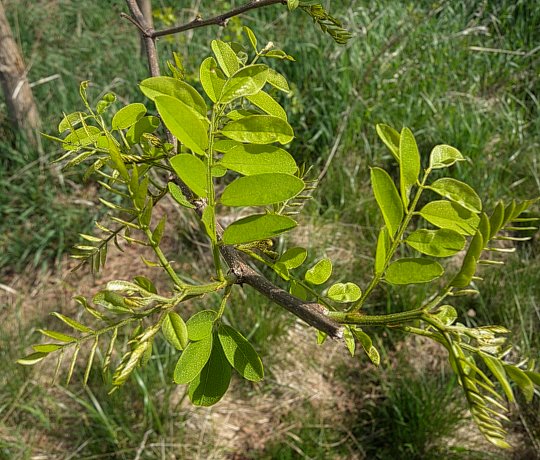
The flowers are produced in drooping racemes about 4-7" long. The central stalk and pedicels of each raceme are pale green and glabrous to slightly pubescent. Individual flowers are ¾-1" long, consisting of 5 white petals, a tubular calyx with 5 teeth, several hidden stamens, and an ovary with a single style. The petals are arranged in a pea-like floral structure consisting of an upright banner and a pair of forward-projecting wings that enclose a keel. There is a small patch of yellow at the base of the banner. The calyx is light green, yellowish green, pinkish green, or brownish green; it is either glabrous or slightly pubescent. The blooming period occurs from late spring to early summer for about 2 weeks after the leaves are fully developed. The flowers have a strong sweet fragrance. Afterwards, fertile flowers are replaced by drooping seedpods that become 2-4" long at maturity during the autumn. Mature seedpods are dark brown, oblongoid in shape, flattened, and either straight or slightly curved; each seed pod contains 4-14 seeds. The seeds are a little less than ¼" long, reniform in shape, dark brown, and somewhat flattened. They are dispersed primarily by gravity, falling to the ground not far from the mother tree. The woody root system produces lateral roots that are usually shallow and widely spreading, although at dry sites it can develop a taproot with deep lateral roots. The root system also produces long underground runners, from which clonal offsets are produced. As a result, this tree often occurs in clonal colonies. The deciduous leaves usually turn yellow during the autumn.
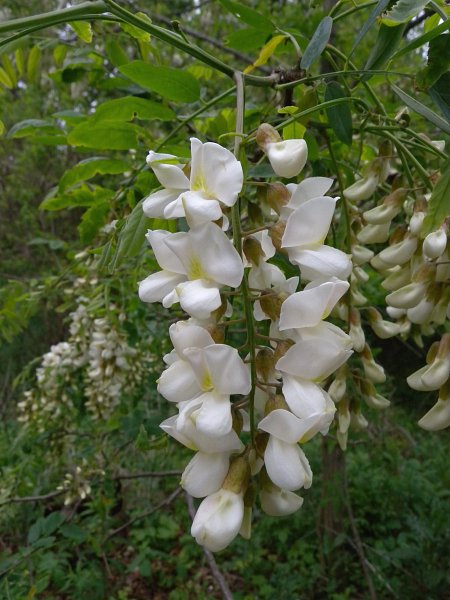
Cultivation: The preference is full sun, mesic to dry-mesic conditions, and a relatively loose soil containing loam, silty loam, or sandy loam. The root system of this tree fixes nitrogen into the soil. Black Locust develops rapidly while it is young, producing seedpods in as little as 6 years. However, it is relatively short-lived with a maximum longevity of about 90 years.
Range & Habitat: Black Locust is occasional throughout Illinois (see Distribution Map). This tree is native to the southern tip of Illinois, otherwise it is either adventive from the south or an escape from cultivation. Habitats include upland woodlands, well-drained areas of bottomland woodlands, disturbed open woodlands, wooded slopes, savannas and sandy savannas, thickets, stabilized sand dunes, strip-mined areas, and roadsides. In Illinois, this tree is an invader of sand prairies and sandy savannas. It is also cultivated as a landscape tree in both suburban and urban settings. Because of its shade intolerance, Black Locust is more common in secondary growth woodlands than old growth forests; habitats with a history of occasional disturbance are preferred.
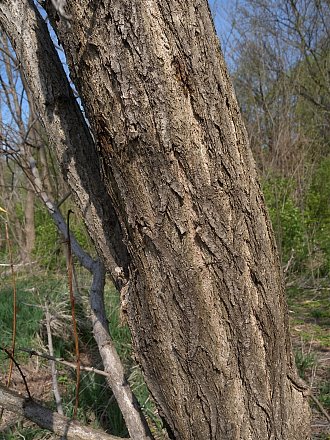
Faunal Associations: The flowers are cross-pollinated primarily by bumblebees, although the Ruby-throated Hummingbird, honeybees, butterflies, and moths also visit the flowers. The floral reward of these visitors is nectar. According to Robertson (1929), butterflies and moths are not effective at cross-pollination, unlike the bees and hummingbird. The foliage of Black Locust is a food source for caterpillars of the skippers Erynnis funeralis (Funereal Duskywing), Erynnis icelus (Dreamy Duskywing), Erynnis zarucco (Zarucco Duskywing), and Epargyreus clarus (Silver-spotted Skipper). The caterpillars of several moths also feed on the foliage; they include such species as Dasylophia anguina (Black-spotted Prominent), Euparthenos nubilis (Locust Underwing), Mellilla xanthometata (Orange Wing), Pero honestaria (Honest Pero), Sciota subcaesiella (Locust Leafroller), and Zale undularis (Black Zale). See the Moth Table for a more complete list of these species. Other insects that feed on this tree include the treehoppers Cyrtolobus fuscipennis, Hadrophallus constans, Stictocephala brevitylus dolichotylus, Telamona decorata, Thelia bimaculata, and Vanduzea arquata; the aphid Aphis cytisorum; the plant bugs Lopidea robiniae (Black Locust Plant Bug) and Orthotylus robiniae; larvae of the wood-boring beetles Agrilus egenus and Megacyllene robiniae (Locust Borer); larvae of the seed beetle Amblycerus robiniae (Locust Seed Borer) and the leaf beetle Odontota dorsalis (Locust Leafminer); larvae of Dasineura pseudacaciae (Black Locust Gall Fly); and many others. See the Insect Table for a more complete list of these species.
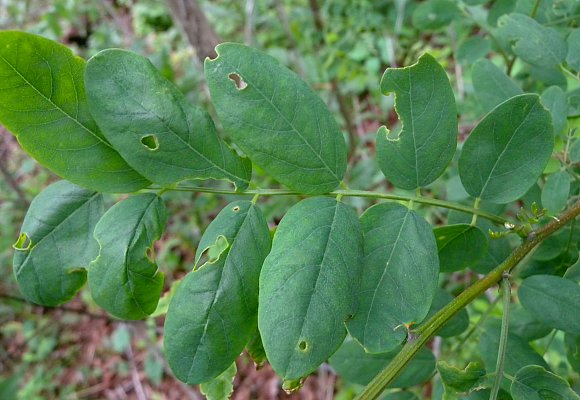
Notwithstanding their toxicity, the seeds are a minor food source of the Thirteen-Lined Ground Squirrel and some upland gamebirds, including the Bobwhite and Ring-Necked Pheasant. While White-Tailed Deer occasionally browse on the foliage of Black Locust without apparent ill effects, it is toxic to such domesticated animals as horses, cattle, and sheep. Because Black Locust is vulnerable to heart-rot fungi, older trees often develop cavities that become dens for bats, screech owls, and woodpeckers. Clonal colonies of Black Locust can provide significant cover for the White-Tailed Deer, Coyote, Red Fox, Striped Skunk, Ring-Necked Pheasant, Bobwhite, and other wildlife in semi-open areas.
Photographic Location: Along an abandoned railroad track near Urbana, Illinois, and border of a yard in NW Ohio. The photographs were taken during early to late spring.
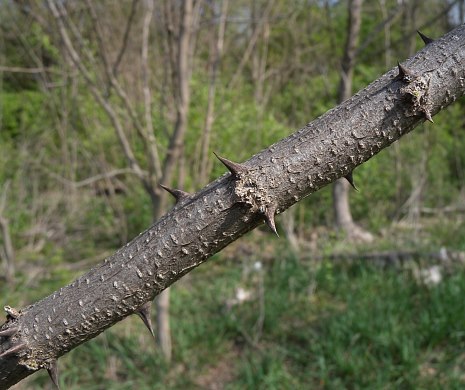
Comments: As a result of the last glaciation, the range of Black Locust was confined to relatively small areas in or around the Appalachian mountains of the east and the Ozark mountains further to the west. Since the time of European settlement, however, the range of this tree has expanded significantly into many areas of the United States, including central and northern Illinois. This dramatic expansion of range is largely the result of its cultivation as a landscape tree, from which it occasionally escapes and naturalizes in surrounding areas. The flowers of this tree are quite showy and fragrant, but short-lived. Other Robinia spp. in Illinois are shrubs less than 30' tall that are more hairy or glandular and their flowers are pink. It is also possible to confuse Black Locust with another native tree, Honey Locust (Gleditsia triacanthos), but this latter species differs by having less showy flowers, smaller leaflets, and more prominent thorns along its trunk, branches, and twigs. Honey Locust also differs by having longer seed pods (exceeding 4" in length) with larger seeds. The wood of Black Locust is heavy, strong, and durable, but it is often damaged by the larvae of Megacyllene robiniae (Locust Borer) and heart-rot fungi before reaching commercial size. Nonetheless, the wood has been used to make fence posts, rail ties, ship timber, boxes and crates, and pulp for paper products.